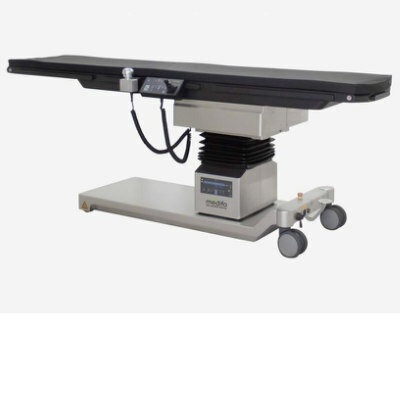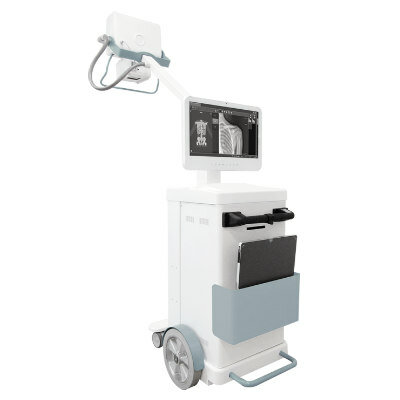3D Printing and CT Imaging Used to Guide Human Face Transplants
|
By MedImaging International staff writers Posted on 17 Dec 2014 |

Image: This shows a 3D print model used in surgical planning (Photo courtyes of RSNA).
Surgeons are using computed tomography (CT) imaging and three-dimensional (3-D) printing technology to reconstruct life-size models of patients’ heads to help better control the outcome in face transplantation surgery.
The study’s findings were presented at the annual meeting of the Radiological Society of North America (RSNA), held in Chicago, IL, USA; November 30 to December 5, 2014. Physicians from Brigham and Women’s Hospital (Boston, MA, USA) performed the first US full-face transplantation in 2011 and have subsequently completed four additional face transplants. The procedure is performed on patients who have lost some or all of their face as a result of disease or injury.
In the study, researchers led by Frank J. Rybicki, MD, radiologist and director of the hospital’s Applied Imaging Science Laboratory, Bohdan Pomahac, MD, lead face transplantation surgeon, and Amir Imanzadeh, MD, research fellow, assessed the clinical impact of using 3-D printed models of the recipient’s head in the planning of face transplantation surgery. “This is a complex surgery and its success is dependent on surgical planning,” Dr. Rybicki said. “Our study demonstrated that if you use this model and hold the skull in your hand, there is no better way to plan the procedure.”
Each of the transplant patients underwent preoperative CT scanning with 3-D visualization. To build each life-size skull model, the CT images of the transplant recipient’s head were segmented and processed using specialized software, creating customized data files that were input into a 3-D printer. “In some patients, we need to modify the recipient’s facial bones prior to transplantation,” Dr. Imanzadeh said. “The 3-D printed model helps us to prepare the facial structures so when the actual transplantation occurs, the surgery goes more smoothly.”
Although the entire transplant procedure lasts as long as 25 hours, the actual vascular connections from the donor face to the recipient typically takes approximately one hour, during which time the patient’s blood flow must be stopped. “If there are absent or missing bony structures needed for reconstruction, we can make modifications based on the 3-D printed model prior to the actual transplantation, instead of taking the time to do alterations during ischemia time,” Dr. Rybicki said. “The 3-D model is important for making the transplant cosmetically appealing.”
Moreover, the researchers reported they employed the models in the operating room to optimize the surgeons’ understanding of the anatomy of the recipient’s face during the procedure. “You can spin, rotate and scroll through as many CT images as you want but there’s no substitute for having the real thing in your hand,” Dr. Rybicki said. “The ability to work with the model gives you an unprecedented level of reassurance and confidence in the procedure.”
Senior surgeons and radiologists involved in the five face transplantations agreed that the 3-D printed models provided superior preoperative data and allowed complex anatomy and bony defects to be better appreciated, reducing total procedure time. “Less time spent in the operating room is better for overall patient outcomes,” Dr. Pomahac added.
Based on the results of this study, 3-D printing is now regularly used for surgical planning for face transplantation procedures at Brigham and Women’s Hospital, and 3-D printed models may be implemented in other complicated surgeries.
Related Links:
Brigham and Women’s Hospital
The study’s findings were presented at the annual meeting of the Radiological Society of North America (RSNA), held in Chicago, IL, USA; November 30 to December 5, 2014. Physicians from Brigham and Women’s Hospital (Boston, MA, USA) performed the first US full-face transplantation in 2011 and have subsequently completed four additional face transplants. The procedure is performed on patients who have lost some or all of their face as a result of disease or injury.
In the study, researchers led by Frank J. Rybicki, MD, radiologist and director of the hospital’s Applied Imaging Science Laboratory, Bohdan Pomahac, MD, lead face transplantation surgeon, and Amir Imanzadeh, MD, research fellow, assessed the clinical impact of using 3-D printed models of the recipient’s head in the planning of face transplantation surgery. “This is a complex surgery and its success is dependent on surgical planning,” Dr. Rybicki said. “Our study demonstrated that if you use this model and hold the skull in your hand, there is no better way to plan the procedure.”
Each of the transplant patients underwent preoperative CT scanning with 3-D visualization. To build each life-size skull model, the CT images of the transplant recipient’s head were segmented and processed using specialized software, creating customized data files that were input into a 3-D printer. “In some patients, we need to modify the recipient’s facial bones prior to transplantation,” Dr. Imanzadeh said. “The 3-D printed model helps us to prepare the facial structures so when the actual transplantation occurs, the surgery goes more smoothly.”
Although the entire transplant procedure lasts as long as 25 hours, the actual vascular connections from the donor face to the recipient typically takes approximately one hour, during which time the patient’s blood flow must be stopped. “If there are absent or missing bony structures needed for reconstruction, we can make modifications based on the 3-D printed model prior to the actual transplantation, instead of taking the time to do alterations during ischemia time,” Dr. Rybicki said. “The 3-D model is important for making the transplant cosmetically appealing.”
Moreover, the researchers reported they employed the models in the operating room to optimize the surgeons’ understanding of the anatomy of the recipient’s face during the procedure. “You can spin, rotate and scroll through as many CT images as you want but there’s no substitute for having the real thing in your hand,” Dr. Rybicki said. “The ability to work with the model gives you an unprecedented level of reassurance and confidence in the procedure.”
Senior surgeons and radiologists involved in the five face transplantations agreed that the 3-D printed models provided superior preoperative data and allowed complex anatomy and bony defects to be better appreciated, reducing total procedure time. “Less time spent in the operating room is better for overall patient outcomes,” Dr. Pomahac added.
Based on the results of this study, 3-D printing is now regularly used for surgical planning for face transplantation procedures at Brigham and Women’s Hospital, and 3-D printed models may be implemented in other complicated surgeries.
Related Links:
Brigham and Women’s Hospital
Latest Radiography News
- Novel Breast Imaging System Proves As Effective As Mammography
- AI Assistance Improves Breast-Cancer Screening by Reducing False Positives
- AI Could Boost Clinical Adoption of Chest DDR
- 3D Mammography Almost Halves Breast Cancer Incidence between Two Screening Tests
- AI Model Predicts 5-Year Breast Cancer Risk from Mammograms
- Deep Learning Framework Detects Fractures in X-Ray Images With 99% Accuracy
- Direct AI-Based Medical X-Ray Imaging System a Paradigm-Shift from Conventional DR and CT
- Chest X-Ray AI Solution Automatically Identifies, Categorizes and Highlights Suspicious Areas
- AI Diagnoses Wrist Fractures As Well As Radiologists
- Annual Mammography Beginning At 40 Cuts Breast Cancer Mortality By 42%
- 3D Human GPS Powered By Light Paves Way for Radiation-Free Minimally-Invasive Surgery
- Novel AI Technology to Revolutionize Cancer Detection in Dense Breasts
- AI Solution Provides Radiologists with 'Second Pair' Of Eyes to Detect Breast Cancers
- AI Helps General Radiologists Achieve Specialist-Level Performance in Interpreting Mammograms
- Novel Imaging Technique Could Transform Breast Cancer Detection
- Computer Program Combines AI and Heat-Imaging Technology for Early Breast Cancer Detection
Channels
MRI
view channel
PET/MRI Improves Diagnostic Accuracy for Prostate Cancer Patients
The Prostate Imaging Reporting and Data System (PI-RADS) is a five-point scale to assess potential prostate cancer in MR images. PI-RADS category 3 which offers an unclear suggestion of clinically significant... Read more
Next Generation MR-Guided Focused Ultrasound Ushers In Future of Incisionless Neurosurgery
Essential tremor, often called familial, idiopathic, or benign tremor, leads to uncontrollable shaking that significantly affects a person’s life. When traditional medications do not alleviate symptoms,... Read more
Two-Part MRI Scan Detects Prostate Cancer More Quickly without Compromising Diagnostic Quality
Prostate cancer ranks as the most prevalent cancer among men. Over the last decade, the introduction of MRI scans has significantly transformed the diagnosis process, marking the most substantial advancement... Read moreUltrasound
view channel
Deep Learning Advances Super-Resolution Ultrasound Imaging
Ultrasound localization microscopy (ULM) is an advanced imaging technique that offers high-resolution visualization of microvascular structures. It employs microbubbles, FDA-approved contrast agents, injected... Read more
Novel Ultrasound-Launched Targeted Nanoparticle Eliminates Biofilm and Bacterial Infection
Biofilms, formed by bacteria aggregating into dense communities for protection against harsh environmental conditions, are a significant contributor to various infectious diseases. Biofilms frequently... Read moreNuclear Medicine
view channel
New SPECT/CT Technique Could Change Imaging Practices and Increase Patient Access
The development of lead-212 (212Pb)-PSMA–based targeted alpha therapy (TAT) is garnering significant interest in treating patients with metastatic castration-resistant prostate cancer. The imaging of 212Pb,... Read moreNew Radiotheranostic System Detects and Treats Ovarian Cancer Noninvasively
Ovarian cancer is the most lethal gynecological cancer, with less than a 30% five-year survival rate for those diagnosed in late stages. Despite surgery and platinum-based chemotherapy being the standard... Read more
AI System Automatically and Reliably Detects Cardiac Amyloidosis Using Scintigraphy Imaging
Cardiac amyloidosis, a condition characterized by the buildup of abnormal protein deposits (amyloids) in the heart muscle, severely affects heart function and can lead to heart failure or death without... Read moreGeneral/Advanced Imaging
view channel
New AI Method Captures Uncertainty in Medical Images
In the field of biomedicine, segmentation is the process of annotating pixels from an important structure in medical images, such as organs or cells. Artificial Intelligence (AI) models are utilized to... Read more.jpg)
CT Coronary Angiography Reduces Need for Invasive Tests to Diagnose Coronary Artery Disease
Coronary artery disease (CAD), one of the leading causes of death worldwide, involves the narrowing of coronary arteries due to atherosclerosis, resulting in insufficient blood flow to the heart muscle.... Read more
Novel Blood Test Could Reduce Need for PET Imaging of Patients with Alzheimer’s
Alzheimer's disease (AD), a condition marked by cognitive decline and the presence of beta-amyloid (Aβ) plaques and neurofibrillary tangles in the brain, poses diagnostic challenges. Amyloid positron emission... Read more.jpg)
CT-Based Deep Learning Algorithm Accurately Differentiates Benign From Malignant Vertebral Fractures
The rise in the aging population is expected to result in a corresponding increase in the prevalence of vertebral fractures which can cause back pain or neurologic compromise, leading to impaired function... Read moreImaging IT
view channel
New Google Cloud Medical Imaging Suite Makes Imaging Healthcare Data More Accessible
Medical imaging is a critical tool used to diagnose patients, and there are billions of medical images scanned globally each year. Imaging data accounts for about 90% of all healthcare data1 and, until... Read more
Global AI in Medical Diagnostics Market to Be Driven by Demand for Image Recognition in Radiology
The global artificial intelligence (AI) in medical diagnostics market is expanding with early disease detection being one of its key applications and image recognition becoming a compelling consumer proposition... Read moreIndustry News
view channel
Bayer and Google Partner on New AI Product for Radiologists
Medical imaging data comprises around 90% of all healthcare data, and it is a highly complex and rich clinical data modality and serves as a vital tool for diagnosing patients. Each year, billions of medical... Read more



















